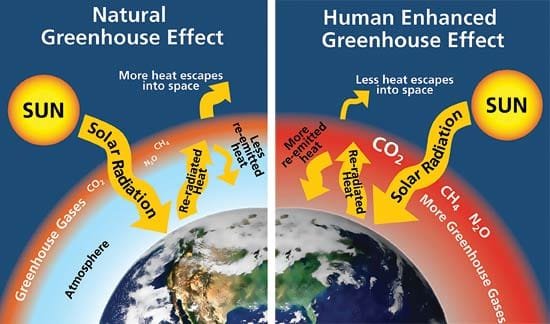Global Warming and the Greenhouse Effect

Global Warming and Greenhouse Effect: Global warming is heating up the globe when the accumulation of greenhouse gases in the atmosphere disturbs the heat budget (balance between incoming and outgoing heat) of the earth, which otherwise remains balanced. Since heat remains trapped within the earth s atmosphere, temperatures begin to rise. Both land and sea temperatures have witnessed a steady increase since 1880 when record-keeping began.
heat budget
Evidence of Global warming – Global Warming and Greenhouse effect
Rise in average surface temperature by 0.95 degrees Celsius as per NOAA ( National Oceanic and Atmospheric Administration.
The average rate of temperature rise has been observed to be nearly 0.07 degrees Celsius per decade.
IPCC predicts the rise in temperature by the end of the 21st century could be up to 5.4 degrees Celsius
16 of the World s hottest years have occurred since 2000, as per NASA records.
Melting of glaciers and polar ice caps and sea-level rise is also evidence of global warming.
Causes of Global Warming
Accumulation of GHGs (Green House Gases) in Atmosphere
The increased volumes of carbon dioxide and other greenhouse gases. These gases collect in the atmosphere and prevent terrestrial radiations to escape the earth s atmosphere, thereby causing global temperatures to rise. Major This is caused by
Burning of Fossil Fuels for generation of electricity or transportation
Forest fires, deliberate clearing of forests for plantation
Agriculture and animal husbandry a major sources of methane.
Download Global Warming And Greenhouse Effect PDF
Elimination of Carbon sinks from the atmosphere
Destruction of natural carbon sinks aids in the build-up of heat-trapping gases in the atmosphere. Major causes behind the removal of carbon sinks are
Encroachment into wetlands





Deforestation – Global Warming and Greenhouse Effect
Eutrophication of lakes and water bodies results in dead zones.
Variations in the earth s orbit and changes in the solar cycle also attribute to global warming.
Deposition of soot, black carbon, etc. acts as positive radiative forcings and also contributes to the warming of temperatures.
Effects of Global Warming
On Climate: Global Warming and Greenhouse Effect
The rise in extreme weather events like Hurricanes and cyclones.
Researchers at MIT have observed that the Atlantic exhibits high thermal potential meaning water can rapidly evaporate into the atmosphere resulting in more favorable conditions for cyclone formation.
A 10-fold increase in the frequency of hurricanes is predicted if the climate becomes 2 degrees C warmer.
Increased frequency of tropical storms due to rise in sea surface temperatures.
On Seas: Global Warming and the Greenhouse Effect
Melting of polar ice caps and receding of glaciers could cause nearly 4 8 inches of rising in sea levels and causes an increased risk of floods and submergence in low-lying areas.
Sea levels are expected to witness a rise of up to 23 inches at the end of the 21st century
On Human Health:
Adverse impact on human health due to the incidence of diseases such as heatstroke during heat waves (NCRB reported a 61% rise in deaths due to heat strokes in 2015 over previous years).
Increase in incidence of epidemics and communicable diseases.
On Agriculture:
Rising input costs due to water shortage
More losses due to pest attacks. On average 5-10% of crops across the country are lost to pests. These are expected to rise as higher temperatures enable pest survival, and higher CO2 concentrations elevate sugar levels in leaves making attacks more severe.
Rising crop losses due to unpredictable weather events.
Farm indebtedness and agrarian distress
On Food Security:
Global warming poses a serious threat to food security. Not only does it account for declining farm productions but also is responsible for disruptions seen in marine ecosystems.
It also could push towards hunger, nearly 220 million Indians that depend on forests for food, nutrition, and livelihood.
Socio-economic impact:
Global warming could push those employed in the primary sector into poverty.
It also makes those living in coastal regions and central India (exposed to heatwaves and drought) more liable to future displacement.
As per UNDP, India will lose 3.6% of its daylight work by 2025 due to rising temperatures.
Apart from this, warming could also trigger conflicts over resources between people.
On Biodiversity and Ecosystem:
Both terrestrial and marine ecosystems have come under stress due to temperature rise which has affected food chains. For instance, 25% of marine biodiversity that is concentrated in and around coral reefs is under direct stress due to rising incidents of mass coral bleaching.
Greenhouse effect
The greenhouse effect refers to the warming of the earth that occurs when CO2 and Greenhouse gases form a blanket around the earth s atmosphere allowing incident solar radiations of higher frequencies to penetrate but preventing outgoing terrestrial radiations from escaping. Joseph Fourier in 1824, calculated that the earth would be 60 degrees Fahrenheit cooler if it had no atmosphere. The atmosphere thus works as a greenhouse and enables life on earth, but anthropogenic emissions of GHGs have caused heat build-up, threatening this very life.
greenhouse effect
Greenhouse Gases what are these?
water vapor – causes 36 70% of the greenhouse effect
carbon dioxide (CO2) – 9 26%
methane (CH4) – 4 9%
ozone (O3) – 3 7%
Nitrous Oxides
Chlorofluorocarbons (CFCs) and Hydrofluorocarbons ( HFC and HCFCs)
GHGs and their global warming potential
Major GHG Contributors
China accounts for 26% of all GHG emissions, followed by US (14%) and the EU.
America is the single biggest contributor to GHG emissions (cumulative)
India accounts for 6% of total GHG emissions
Per capita emissions from China stand at 6.5 mt, the US at 15 mt, and India at 1.5 mt
What causes GHG emissions
The burning of fossil fuels for industrial use, electricity generation, and transportation
Agriculture, Livestock, and Animal Husbandry Burning crop residues, Meat rich diets (more than 100g per day) contribute about 7.2 kg of CO2 per day against vegan diet contributing 2.9 kg CO2 per day.
Landfill sites, garbage, and sewage dumping sites.
Forest clearing, shifting cultivation
GHG Emissions by sectors
What has been done to reduce GHG concentrations in the atmosphere?
In India
India is ranked 14th in this year’s Climate Change Performance Index (CCPI) 2018 out of 56 nations. India aims to reduce greenhouse gas emissions by at least 40 percent and increase energy efficiency and share of renewables by at least 27 percent by 2030. Other measures taken include –
Switch to cleaner fuels: Ujjwala Scheme helped women switch from challah to LPG, Increasing the share of renewable energy in the energy mix (Solar mission)
Energy efficiency initiatives Ujala initiative, Transition to supercritical thermal power plants.
The principle of polluter pay Increase in coal cess to make it costlier.
Arresting vehicular emissions FAME Initiative planned the transition to BS-VI fuels.
Conserving forests Compensatory afforestation, Joint Forest Management (under National forest policy).
What has the world done in recent years?
Under UNFCCC, countries signed the Kyoto Protocol which came into effect in 2005. Developed countries, hereby accepted legally binding targets to curb their carbon emissions
At the United Nations Conference on Climate Change held in Paris in 2016, 195 nations agreed to prevent temperature rise beyond 1.5 degrees Celsius above average temperature during preindustrial times.
In Kigali, an amendment to the Montreal Protocol was signed between countries to gradually phase out HFCs that have high global warming potential.
What needs to be done?
GHG concentration in the atmosphere needs to be capped at 450 550 ppm ( Currently it is 380 ppm)
As per IPCC, global GHG emissions must be reduced by 50-80 % of their current values.
Focus on energy conservation and energy efficiency.
Technological advancements to be made in the field of GHG sequestration ( Capturing gases in the atmosphere and storing them underground)
Creating and Protecting Carbon Sinks Forests and wetlands.
| Top NDA Coaching in India | Top CDS Coaching in India |
| Top SSB Coaching in India | Top Air Force Coaching in India |











